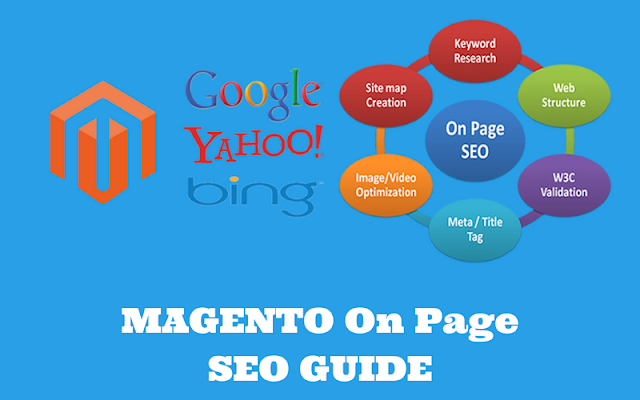the most important aspects of any Magento store. It’s not only the off-page SEO
which includes citations and links that is important but even the on-page
optimizations can be a major contributing factor towards promoting our website.
In-fact on-page optimizations, if implemented efficiently can be lead to a
major lead generation and ultimately considerable boost in sales over our
online store. With more than 80% of online users perform a search on popular
search engines for the products they are interested in, SEO is no longer an
option, it just has to be there if we need to ensure continued growth in the
highly competitive online marketing scenario. While utilizing Magento as a
Content Management System (CMS) for our website, we can make use of various Magento On Page SEO settings to ensure best results.
some of the most impressive and popular tips which are sure to work out for
online stores.
1.
Meta Tags
a page on our website. It informs the search engine of the content of the page.
Proper meta tags come in pretty handy in ensuring a higher rank of our store on
search engines.
– Meta Tags
for Products:
meta description and title for product pages on our website at Catalog ->
Products -> Select & Edit Product -> Search Engine Optimization. The
newly introduced feature of Products field Auto-Generation can also be used in
this case.
– Meta Tags
for Content Pages:
tags for content pages can be changed from Content -> Pages -> {Content
Page} -> Search Engine Optimization.
– Meta Tags
for Categories:
setting for categories can be found at Catalog -> Categories -> Search
Engine Optimization.
2. URLs
products are generated automatically and Magento provides us with options to
modify the respective URL Keys.
at Catalog -> Products -> {Product} -> Search Engine Optimization
-> URL Key
modified at Catalog -> Categories -> {Category} -> Search Engine
Optimization -> URL Key
3. Website’s Title Tag, Prefix, and Suffix
the store page is considered as a good practice. This can be done at Content
-> Configuration -> Website -> HTML Head -> Page Title Prefix &
Suffix. This is one of the important Magento
SEO tips to be kept in mind during the development of the store.
4. Product and Category URL Suffix
suffix for product and category pages on our website. This can be found at
Stores -> Configuration -> Catalog -> Search Engine Optimization.
Although the configuration settings allow us to have a different suffix for
Category and Products, it is not recommended to do so.
5. Image Optimization:-
significant factors while deciding the rank of a website by search engines for
any relevant search made on them. Hence, it becomes important to properly
manage images in our store for better site performance. Latest Magento version
allows us to add an alt attribute for better image optimization. The same can
be found at Catalog -> Products -> {Product} -> Images and Video ->
Alt Text.
store logo which is “Magento Commerce” by default. This can be done at Stores
-> Configuration -> General -> Design -> HTML head -> Header
6. Google Analytics
Stores -> Configuration -> Sales -> Google API -> Google Analytics.
In order to enable Google Analytics on our store, we first need a Google
Analytics account. We can also add a Google Analytics Experiment Code to any of
the product pages available in our store from Product -> Advanced Settings
-> Product View Optimization.
7. Google
AdWords
relatively simple in the latest version of Magento. The configuration for the
same can be done at Stores -> Configuration -> Sales -> Google API
-> Google AdWords Details, the details to be filled up in respective fields
can be found in our Google AdWords Account.
8. Efficient Indexing
following things into consideration:
– Robots.txt
specify the list of URLs to be indexed by search engines and a list of URLs
which we do not wish to be indexed in this file. The setting for the same can
be found at Content -> Configuration -> Search Engine Robots. The Default Robots option is set to INDEX,FOLLOW and this value should
be customized only if we need to.
– XML
Sitemap
generate the XML sitemap of our online store at Stores -> Configuration
-> Catalog -> XML Sitemap. Here we can also set the frequency of update
for the sitemap based on the frequency of updates made to our store such that
search engines always index the latest sitemap which contains all the updated
products and categories.
to consider for any expert Magento developer of a reputed Magento development company while developing an online store for
their clients. The aforementioned points are sure to act as an on-page SEO guide for all existing and
upcoming Magento stores. These steps are sure to provide a considerable boost
to the popularity of our online store and also generate more and more leads
which would eventually lead to an improvement in sales and ultimately more
profit to our business.
About
Author:
HireMagentoGeeks Ltd, a company that provides Magento development services in a
convenient manner. She is a passionate writer and loves to share Magento
relates tutorials.



